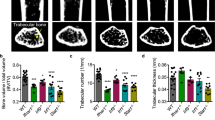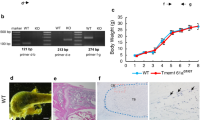Abstract
Interferon-inducible transmembrane protein 5 (IFITM5) is an osteoblast-specific membrane protein whose expression peaks around the early mineralization stage during the osteoblast maturation process. To investigate IFITM5 function, we first sought to identify which proteins interact with IFITM5. Liquid chromatography mass spectrometry revealed that FK506-binding protein 11 (FKBP11) co-immunoprecipitated with IFITM5. FKBP11 is the only protein it was found to interact with in osteoblasts, while IFITM5 interacts with several proteins in fibroblasts. FKBPs are involved in protein folding and immunosuppressant binding, but we could not be sure that IFITM5 participated in these activities when bound to FKBP11. Thus, we generated Ifitm5-deficient mice and analyzed their skeletal phenotypes. The skeletons, especially the long bones, of homozygous mutants (Ifitm5 −/−) were smaller than those of heterozygous mutants (Ifitm5 +/−), although we did not observe any significant differences in bone morphometric parameters. The effect of Ifitm5 deficiency on bone formation was more significant in newborns than in young and adult mice, suggesting that Ifitm5 deficiency might have a greater effect on prenatal bone development. Overall, the effect of Ifitm5 deficiency on bone formation was less than we expected. We hypothesize that this may have resulted from a compensatory mechanism in Ifitm5-deficient mice.








Similar content being viewed by others
References
Hanagata N, Takemura T, Monkawa A, Ikoma T, Tanaka J (2007) Phenotype and gene expression pattern of osteoblast-like cells cultured on polystyrene and hydroxyapatite with pre-adsorbed type-I collagen. J Biomed Mater Res Part A 83A:362–371
Lange UC, Saitou M, Western PS, Barton SC, Surani MA (2003) The fragilis interferon-inducible gene family of transmembrane proteins is associated with germ cell specification in mice. BMC Dev Biol 3:1–11
Evans SS, Lee DB, Han T, Tomasi TB, Evans RL (1990) Monoclonal antibody to the interferon-inducible protein Leu-13 triggers aggregation and inhibits proliferation of leukemic B cells. Blood 76:2583–2693
Evans SS, Colla RP, Leasure JA, Lee DB (1993) IFN-α induces homotypic adhesion and Leu-13 expression in human B lymphoid cells. J Immunol 150:736–747
Friedman RL, Manley SP, Mcahon M, Kerr IM, Stark GR (1984) Transcriptional and posttranscriptional regulation of interferon-induced gene expression in human cells. Cell 38:745–755
Kelly JM, Gilbert CS, Stark GR, Kerr IM (1985) Differential regulation of interferon-induced mRNAs and c-myc mRNA by α- and β-interferons. Eur J Biochem 153:367–371
Bradbury LE, Kansas GS, Levy S, Evans RL, Tedder TF (1992) The CD19/CD21 signal transducing complex of human B lymphocytes induces the target of antiproliferative antibody-1 and Leu-13 molecules. J Immunol 149:2841–2850
Deblandre GA, Marinx OP, Evans SS, Majjaj S, Leo O, Caput D, Huez GA, Wathelet MG (1995) Expression cloning of an interferon-inducible 17-kDa membrane protein implicated in the control of cell growth. J Biol Chem 270:23860–23866
Zucchi I, Montagna C, Susani L, Vezzoni P, Dulbecco R (1998) The rat gene homologous to the human gene 9-27 is involved in the development of the mammary gland. Proc Natl Acad Sci USA 95:1079–1084
Zucchi I, Montagna C, Susani L, Montesano R, Affer M, Zanotti S, Redolfi E, Vezzoni P, Dulbecco R (1999) Genetic dissection of dome formation in a mammary cell line: identification of two genes with opposing action. Proc Natl Acad Sci USA 96:13766–13770
Zucchi I, Bini L, Valaperta R, Ginestra A, Albani D, Susani L, Sanchez JC, Liberatori S, Magi B, Raggiaschi R, Hochstrasser DF, Pallini V, Vezzoni P, Dulbecco R (2001) Proteomic dissection of dome formation in a mammary cell line: role of tropomyosin-5b and maspin. Proc Natl Acad Sci USA 98:5608–5613
Zucchi I, Prinetti A, Scotti M, Valaperta R, Mento E, Reinbold R, Vezzoni P, Sonnino S, Albertini A, Dulbecco R (2004) Association of rat8 with Fyn protein kinase via lipid rafts is required for rat mammary cell differentiation in vitro. Proc Natl Acad Sci USA 101:1880–1885
Saitou M, Barton SC, Surani MA (2002) A molecular programme for the specification of germ cell fate in mice. Nature 418:293–300
Tanaka SS, Nagamatsu G, Tokitake Y, Kasa M, Tam PPL, Matsui Y (2004) Regulation of expression of mouse interferon-induced transmembrane protein like gene-3, Ifitm3 (mil-1, fragilis), in germ cells. Dev Dyn 230:651–659
Komori T, Yagi H, Nomura S, Yamaguchi A, Sasaki K, Deguchi K, Shimizu Y, Bronson RT, Gao Y-H, Inada M, Sato M, Okamoto R, Kitamura Y, Yoshiki S, Kishimoto T (1997) Targeted disruption of Cbfa1 results in a complete lack of bone formation owing to maturational arrest of osteoblasts. Cell 89:755–764
Inada M, Yasui T, Nomura S, Miyake S, Deguchi K, Himeno M, Sato M, Yamagiwa H, Kimura T, Yasui N et al (1999) Maturational disturbance of chondrocytes in Cbfa1-deficient mice. Dev Dyn 214:279–290
Nakashima K, Zhou X, Kunkel G, Zhang Z, Deng JM, Behringer RR, de Crombrugghe B (2002) The novel zinc finger-containing transcription factor osterix is required for osteoblast differentiation and bone formation. Cell 108:17–29
Hauschka P, Lian J, Cole D, Gundberg C (1989) Osteocalcin and matrix Gla protein: vitamin K-dependent proteins in bone. Physiol Rev 69:990–1047
Ducy P, Desbois C, Boyce B, Pinero G, Story B, Dunstan C, Smith E, Bonadio J, Goldstein S, Gundberg C, Bradley A, Karsenty G (1996) Increased bone formation in osteocalcin-deficient mice. Nature 382:448–452
Malaval L, Wade-Gueye NM, Boudiffa M, Fei J, Zirngibl R, Chen F, Laroche N, Roux J-P, Burt-Pichat B, Duboeuf F, Boivin G, Jurdic P, Lafage-Proust M-H, Amedee J, Vico L, Rossant J, Aubin J (2008) Bone sialoprotein plays a functional role in bone formation and osteoclastogenesis. J Exp Med 205:1145–1153
Thomas G, Moffatt P, Salois P, Gaumond M-H, Gingras R, Godin E, Miao D, Goltzman D, Lancotot C (2003) Osteocrin, a novel bone-specific secreted protein that modulates the osteoblast phenotype. J Biol Chem 278:50563–50571
Rulten SL, Kinloch RA, Tateossian H, Robinson C, Gettins L, Kay JE (2006) The human FK506-binding proteins: characterization of human FKBP11. Mamm Genome 17:322–331
Kodama H, Amagai Y, Sudo H, Kasai S, Yamamoto S (1981) Establishment of a clonal osteogenetic cell line from newborn mouse calvaria. Jpn J Oral Biol 23:899–901
Sudo H, Kodama HA, Amagi Y, Yamamoto S, Kasai S (1983) In vitro differentiation and calcification in a new clonal osteogenic cell line derived from newborn mouse calvaria. J Cell Biol 96:191–198
Galat A (2003) Peptidyl prolyl cis/trans isomerases (immunophilins): biological diversity-targets-functions. Curr Top Med Chem 3:1315–1347
Moffatt P, Gaumond M-H, Salois P, Sellin K, Bessette M-C, Godin E, de Oliveira PT, Atkins GJ, Nanci A, Thomas G (2008) Bril, a novel bone-specific modulator of mineralization. J Bone Miner Res 23:1497–1508
Midura RJ, Wang A, Lovitch D, Law D, Powell K, Gorski JP (2004) Bone acidic glycoprotein-75 delineates the extracellular sites of future bone sialoprotein accumulation and apatite nucleation in osteoblastic cultures. J Biol Chem 279:25464–25473
Gorski JP, Wang A, Lovitch D, Law D, Powell K, Midura RJ (2004) Extracellular bone acidic glycoprotein-75 defines condensed mesenchyme regions to be mineralized and localizes with bone sialoprotein during intramembranous bone formation. J Biol Chem 279:25455–25463
Caplan AI, Pechak DG (1987) The cellular and molecular embryology of bone formation. In: Peck WA (ed) Bone and mineral research, vol 5. Elsevier, New York, pp 117–183
Kay JE (1996) Structure–function relationships in the FK506-binding protein (FKBP) family of peptidylprolyl cis–trans isomerases. Biochem J 314:361–385
Galat A (1993) Peptidylproline cis–trans-isomerases: immunophilins. Eur J Biochem 216:689–707
Winslow MM, Pan MG, Starbuck M, Gallo EM, Deng L, Karsenty G, Crabtree GR (2006) Calcineurin/NFAT signaling in osteoblasts regulates bone mass. Dev Cell 10:771–782
Koga T, Matsui Y, Asagiri M, Kodama T, de Crombrugghe B, Nakashima K, Takayama H (2005) NFAT and Osterix cooperatively regulate bone formation. Nat Med 11:880–885
Tanaka SS, Yamaguchi YL, Tsoi B, Lickert H, Tam PP (2005) IFITM/Mil/fragilis family proteins IFITM and IFITM3 play distinct roles in mouse primordial germ cell homing and repulsion. Dev Cell 9:723–724
Rubinstein E, Ziyyat A, Prenant M, Wrobel E, Wolf J-P, Levy S, Le Nauour F, Boucheix C (2006) Reduced fertility of female mice lacking CD81. Dev Biol 290:351–358
Brass AL, Huang I-C, Benita Y, John SP, Krishnan MN et al (2009) The IFITM5 proteins mediate cellular resistance to influenza A H1N1 virus, West nile virus, and dengue virus. Cell 139:1243–1254
Acknowledgments
We are grateful to Ms S. Kajiwara and M. Maeda for their technical assistance. We also would like to thank Dr. T. Koda for his useful advice in knockout mice analysis. Part of this research was funded by the Research Promotion Bureau of the Ministry of Education, Culture, Sports, Science and Technology (MEXT), Japan.
Author information
Authors and Affiliations
Corresponding author
About this article
Cite this article
Hanagata, N., Li, X., Morita, H. et al. Characterization of the osteoblast-specific transmembrane protein IFITM5 and analysis of IFITM5-deficient mice. J Bone Miner Metab 29, 279–290 (2011). https://doi.org/10.1007/s00774-010-0221-0
Received:
Accepted:
Published:
Issue Date:
DOI: https://doi.org/10.1007/s00774-010-0221-0




